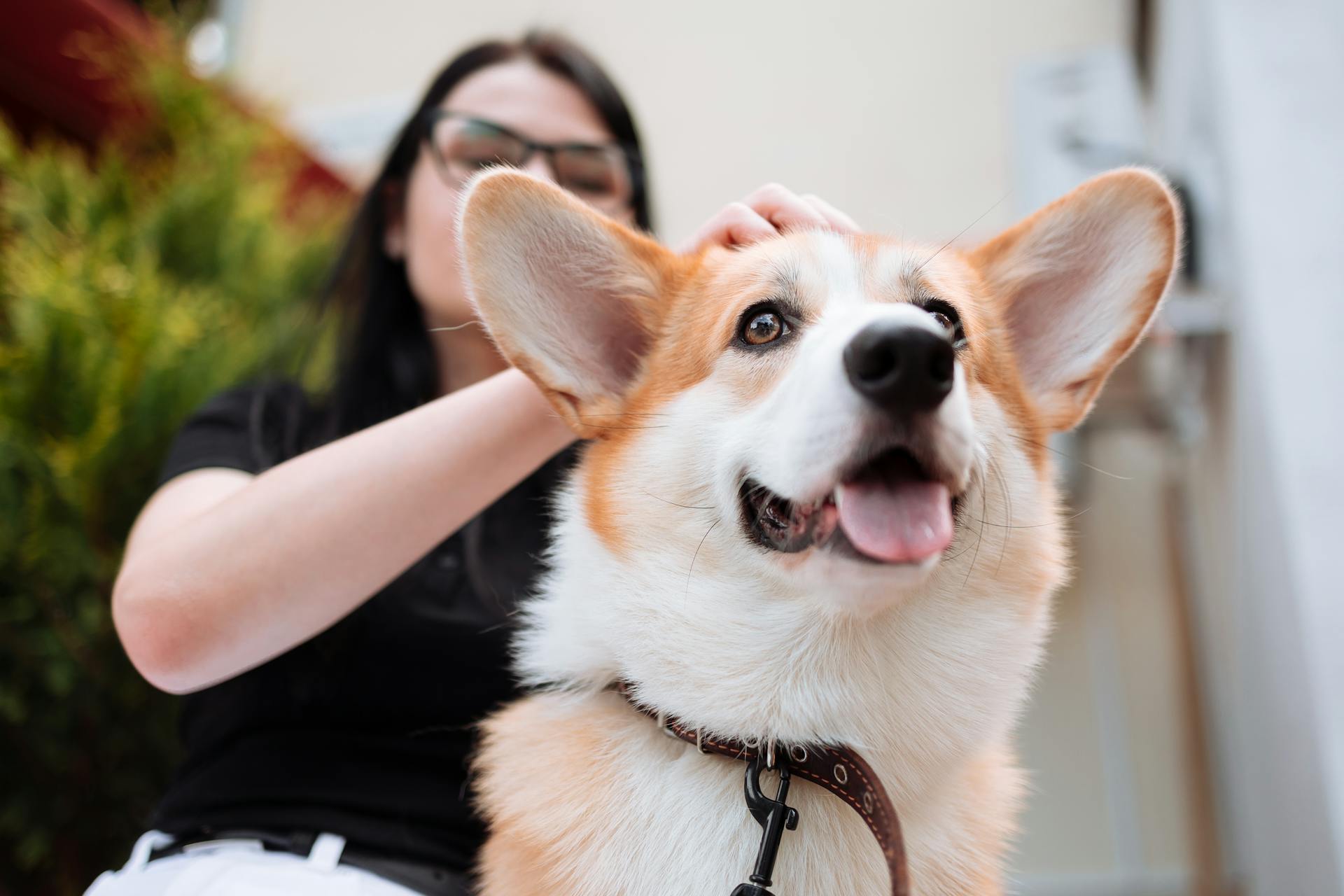
Shih Tzus are prone to back leg problems due to their physical characteristics and genetic predispositions.
Their short legs and long body can put a lot of strain on their back legs, leading to issues such as hip dysplasia and arthritis.
Regular exercise is essential to maintain healthy joints and muscles in Shih Tzus.
However, over-exertion can exacerbate back leg problems, so it's essential to balance physical activity with rest and relaxation.
Causes and Symptoms
Shih Tzu back leg problems can be a real concern for pet owners. Intervertebral disc disease (IVDD) is a common cause of back leg weakness in dogs, and it can affect Shih Tzus too.
IVDD is a sudden onset of ataxia or paralysis in adult dogs of any age, often associated with severe back pain. It's essential to see a vet as soon as possible.
Other potential causes of back leg weakness in Shih Tzus include tick paralysis, lumbosacral stenosis, and fibrocartilagenous embolism. These conditions can be life-threatening if left untreated.
Take a look at this: Problems with German Shepherds Back Legs
Tick paralysis is a high-risk condition in areas with scrub or bushland, so if you live in such an area, it's crucial to take precautions.
Shih Tzus may also be prone to polyradiculoneuritis, an autoimmune disease of the nerves believed to be triggered by Campylobacter exposure from raw chicken.
Early signs of back leg weakness in Shih Tzus can include difficulty rising from lying down or sitting, exercise intolerance, and stiff or abnormal gait.
Other indicators of back leg weakness include trembling of the legs, difficulty getting on and off furniture or climbing stairs, and signs of pain such as increased panting or limping.
If you notice any of these signs, it's always best to make an appointment to speak with your veterinarian.
Here are some potential causes of back leg weakness in dogs, categorized for easy reference:
- Orthopedic: e.g. fractures and trauma, lumbosacral stenosis, hemivertebra
- Neurological: e.g. intervertebral disc disease (IVDD), polyradiculoneuritis, myasthenia gravis
- Metabolic / Endocrine: e.g. low thyroid levels, hypothyroidism
- Cardiac: e.g. heart conditions that can cause weakness in the back legs
- Infectious Diseases: e.g. tick paralysis, botulism
- Trauma: e.g. fractures and trauma to the spine
- Muscular: e.g. muscular dystrophy, muscle wastage or atrophying around the rear legs
It's essential to get a definitive diagnosis of the underlying condition from your vet to ensure your Shih Tzu receives the right treatment.
Understanding IVDD
IVDD, or Intervertebral Disc Disease, is a common condition in dogs that can cause sudden hind limb weakness or collapse.
This condition is especially common in smaller breed dogs, such as Dachshunds.
Between each vertebra, there are cartilage discs that cushion the backbone as a dog moves.
In IVDD, these discs get displaced or herniate, putting pressure on the spinal cord.
Dogs with mild IVDD may only have back pain or leg weakness.
Severe spinal cord compression from IVDD can lead to complete, sometimes irreversible, paralysis.
Time is of the essence for dogs with IVDD because the sooner the vet can start treatment, the better the chances of recovery.
Sometimes dogs with IVDD can recover without surgery, but other cases require IVDD surgery in dogs.
Treatment and Medication
Treatment for Shih Tzu back leg problems can vary depending on the underlying cause, but your vet will work with you to find the best approach.
Dogs with IVDD may need surgery or medical management, while those with metabolic diseases will have treatment tailored to the specific condition.
Trauma and shock are treated on a case-by-case basis.
Unfortunately, there is no effective treatment for degenerative myelopathy, but symptomatic medical management can make some dogs more comfortable.
For Shih Tzus with hind leg collapse due to arthritis, multimodal treatment can make a huge difference.
NSAIDs can be very effective in reducing pain and inflammation associated with arthritis, and some dogs may even act like puppies again on these medications.
Some dogs may also benefit from other types of pain medication, such as tramadol or gabapentin.
What to Do
If your Shih Tzu's back legs just collapsed, get them to the vet immediately. Hind leg collapse is considered an emergency.
Your vet will discuss possible differential diagnoses after listening to your history and performing a physical exam. They may want to get some X-rays of the back legs, spine, and pelvis to see what's going on with the bones, joints, or organs.
Running baseline bloodwork is a good idea to identify or rule out metabolic causes of hind leg weakness. This also ensures your dog is healthy enough to metabolize new medications.
Treatment depends on the cause of your dog's rear leg weakness. Sometimes it's a symptom of an incurable condition, but other times, a dog can recover with the right treatment.
If your Shih Tzu has arthritis, multimodal treatment can make a huge difference. This can include a combination of medication, pain relief, and physical therapy.
To help your dog, consider using mobility aids like wheelchairs or Maximus Paws Up, especially if they're having trouble walking. Rear lift harnesses can also be helpful, especially if your dog needs to get up and down stairs.
Maintaining a healthy weight is crucial to reduce stress on the joints. Being overweight makes everything more difficult for a dog, so make sure your Shih Tzu is at a healthy weight.
Here are some ways to prevent rear leg weakness from happening:
- Keep your dog safe from car accidents
- Stop your dog from jumping off high surfaces
- Check for ticks
- Consider a joint supplement for arthritis and osteoarthritis
- Ensure regular veterinary check-ups
- Consider genetic testing if your dog is predisposed to a breed-specific, inherited condition
Preventing Rear Weakness
Protecting your Shih Tzu from rear leg weakness is impossible, but you can minimize some risks through common sense.
Keep your dog safe from car accidents and high surfaces to avoid injuries.
Regular veterinary check-ups are essential to detect potential health issues early on.
Genetic testing can be considered if you know your dog might be predisposed to breed-specific conditions.
Maintaining your Shih Tzu's health through exercise, good nutrition, and the right weight can also help prevent rear leg weakness.
A joint supplement may be beneficial for arthritis and osteoarthritis prevention.
Take a look at this: Define Shih Tzu
Diagnosis and Referral
Your veterinarian may recommend a consultation with a specialist if your Shih Tzu's back leg problems require advanced testing or complex surgical procedures.
A veterinary specialist, such as a neurologist or orthopedic surgeon, can handle less straightforward cases and perform procedures like spinal cord decompression for IVDD dogs.
These specialists are well-equipped to handle advanced testing like MRI or CT scans, which may be necessary to diagnose the underlying issue.
Veterinary Specialist Referral
Your veterinarian may recommend a consultation with a specialist if they're unsure about your dog's condition or need advanced testing.
Referral to a veterinary specialist can be a good idea if your dog needs more complex surgical procedures, such as a TPLO surgery for dogs with a torn ACL or spinal cord decompression for IVDD dogs.
A veterinary specialist can perform more advanced testing, like MRI or CT scans, to help diagnose your dog's condition.
These specialists are well-equipped to handle cases that are less straightforward, and can provide a second opinion if your veterinarian is unsure about your dog's diagnosis or treatment plan.
You know your dog best, so if you're concerned about their condition, don't hesitate to talk to your veterinarian.
Your veterinarian can help you get to the bottom of the problem, tell you what to expect, and formulate a treatment plan that's tailored to your dog's needs.
Diagnosing Patellar Luxation
Diagnosing patellar luxation requires a thorough examination of your dog. You should take your dog to the vet if you suspect patellar luxation, as they can perform a physical exam to check for the condition.
The vet will watch your dog walk and feel the back legs to check for muscle wastage and sideways movement in the kneecap. This is a crucial step in diagnosing patellar luxation.
The vet will also x-ray the leg to fully assess the underlying anatomy, especially if corrective surgery is being considered. X-rays are essential in determining the severity of the condition.
In mild cases of patellar luxation, your vet may recommend managing your dog's pain and inflammation with NSAIDs. This can help alleviate your dog's discomfort and prevent further complications.
In severe cases, corrective surgery may be necessary to protect the joint from early arthritis. Your vet will advise you on the best course of action based on the severity of the condition.
Here are the steps to diagnose patellar luxation:
- Get a physical exam to check for muscle wastage and sideways movement in the kneecap.
- X-ray the leg to fully assess the underlying anatomy.
- Manage the condition with NSAIDs in mild cases.
- Undergo surgery in severe cases to protect the joint from early arthritis.
Frequently Asked Questions
Why is my Shih Tzu struggling to walk?
Your Shih Tzu's walking struggles may be due to a hip joint displacement causing degenerative joint disease or arthritis, which can worsen with age
What to do when your dog's back legs keep giving out?
Seek urgent veterinary care if your dog's back legs keep giving out, as it could be a sign of a serious injury such as a cranial cruciate tear or broken bone
How long can dogs live with weak back legs?
Dogs with degenerative myelopathy typically live 1-2 years after diagnosis, during which time they may experience progressive weakness and loss of control over their legs, bladder, and bowels. If you suspect your dog has this condition, it's essential to consult with a veterinarian for proper diagnosis and care.
Why would a dogs hind legs stop working?
Dogs' hind legs can stop working due to age-related conditions, injuries, or degenerative diseases affecting the spine, hips, or hind legs. If your dog is experiencing hind leg weakness, it's essential to consult a veterinarian for proper diagnosis and treatment
How do you treat hip dysplasia in Shih Tzus?
Surgical treatment options for hip dysplasia in Shih Tzus include total hip replacement, femoral head/neck ostectomy, and other procedures such as triple pelvic osteotomy and arthroplasty
Sources
- https://www.walkervillevet.com.au/blog/ataxia-weak-back-legs-in-dogs/
- https://toegrips.com/old-dog-back-legs-collapsing/
- https://www.dig-in.com.au/5-common-health-problems-for-shih-tzu-dogs/
- https://www.wikihow.com/Diagnose-Patellar-Luxation-in-Shih-Tzus
- https://zoomadog.co.uk/collections/rear-leg-weakness-in-your-dog
Featured Images: pexels.com


